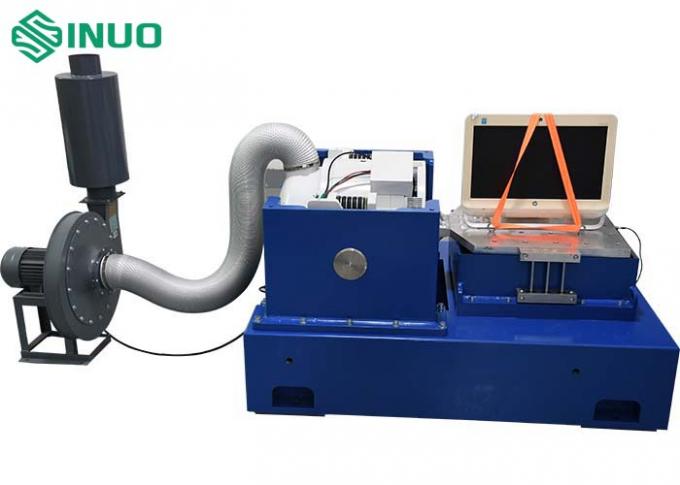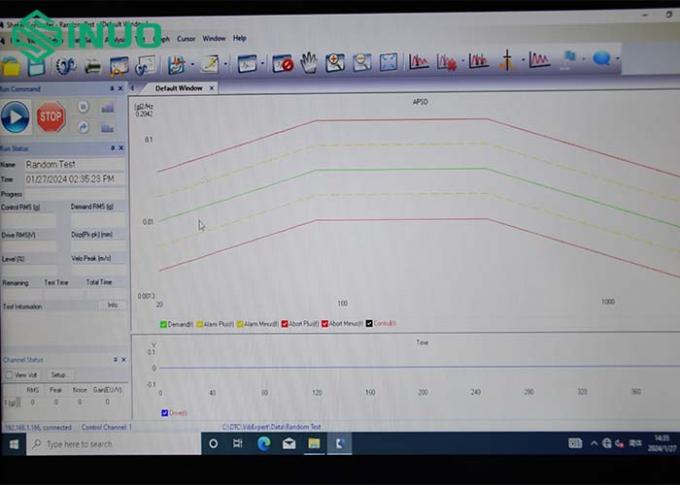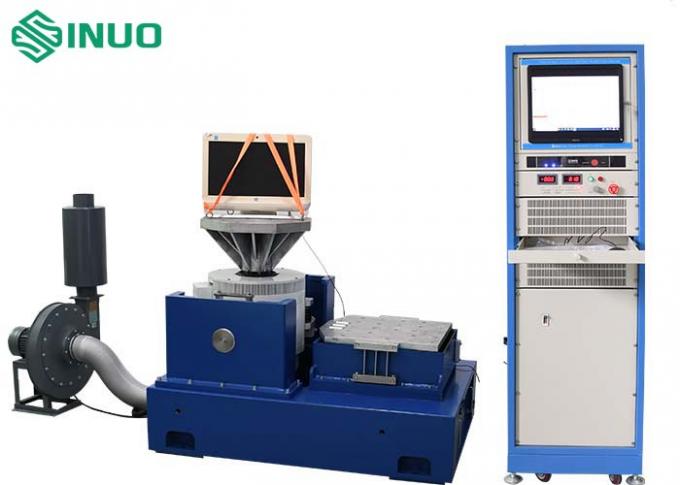

A cell vibration test system refers to a specialized apparatus or setup used to subject cells or batteries to controlled vibrations for testing and evaluation purposes. These tests are conducted to assess the performance, durability, and reliability of cells or batteries under various vibration conditions, simulating real-world scenarios or specific application requirements.
The cell vibration test system typically consists of the following components:
Vibration Platform: It is a sturdy platform or fixture designed to securely hold and subject the cells or batteries to controlled vibrations. The platform may have adjustable fixtures or clamps to accommodate different cell sizes and configurations.
Vibration Generator: This is the core component of the system responsible for generating controlled vibrations. It can produce vibrations in different directions (vertical, horizontal, or multi-axis) and with variable frequencies, amplitudes, and waveforms. The vibration generator is often driven by an electric motor or an electrodynamic shaker.
Control System: The control system regulates the parameters of the vibration test, such as frequency, amplitude, and duration. It allows precise control and adjustment of the vibration conditions to meet the desired testing criteria. The control system may include software or programmable controls for automation and data logging.
Fixturing and Mounting: The test system includes specialized fixtures or mounting mechanisms to securely hold the cells or batteries on the vibration platform. These fixtures ensure proper alignment and contact with the platform to accurately transmit vibrations to the test samples.
Monitoring and Measurement: Sensors and measurement instruments are utilized to monitor and measure various parameters during the vibration test. These may include accelerometers to measure vibration acceleration, strain gauges to analyze deformation or stress, and temperature sensors to monitor temperature changes during the test.
Safety Measures: Safety considerations are essential in a cell vibration test system to prevent accidents or damage. This may include features like emergency stop buttons, protective enclosures, and interlocks to ensure operator safety during testing.
Cell vibration testing helps evaluate the mechanical robustness, structural integrity, and performance characteristics of cells or batteries under vibration-induced stresses. It is particularly important for industries such as automotive, aerospace, and portable electronics, where cells or batteries are exposed to vibrations during transportation, operation, or harsh environmental conditions.
The specific test parameters, standards, and procedures for cell vibration testing may vary depending on the application, industry, and regulatory requirements. It is essential to consult the relevant standards (such as IEC, ASTM, or industry-specific standards) and follow established guidelines to conduct accurate and reliable cell vibration testing.

The electric vibration test system is a precision testing equipment that simulates the damage of products and individual components in the actual working environment.
Its working principle is similar to that of a speaker, that is, the energized conductor is acted upon by a force in the magnetic field. This force is the excitation force of the vibration test bench.
The working process of the system is that the excitation coil and the moving coil in the table body form two mutually perpendicular magnetic fields when energized. The two magnetic fields cut the magnetic lines of force with each other to generate excitation force.
The vibration acceleration (a), amplitude (mm), frequency (HZ) and other indicators generated in these excitation phenomena are input to the vibration controller through the vibration sensor.

The controller analyzes and processes the output to the preamplifier and power amplifier, and then the power amplifier to the stage body, and so on, to keep the vibration test system running within a stable test index. In this process, the cooling fan is used to cool the heat generated by two mutually perpendicular magnetic fields passing current.
The temperature generated in the magnetic field cannot be higher than 110°C, otherwise it will cause the temperature to be too high and cause an alarm. This requires that the laboratory environment temperature where the vibration test system is located must be at normal temperature.
According to F=ma (Newton's second law), m is all the loads on the vibration test bench. This includes the weight of the test product m1, the weight of the tooling fixture m2, the weight of the moving parts of the shaking table (moving coil) m3, and the weight of the extended platform of the shaking table m4, that is, total m = m1+m2+m3+m4. a is the acceleration generated during the vibration test, and the product of m and a can calculate the thrust required for the vibration test.
In addition, if acceleration is not given in the relevant standards, only frequency and displacement (amplitude) are given. The acceleration a can be calculated according to the formula: a=f2*d/250, where f is the frequency (HZ) and d is the amplitude (mm). d in this formula is the single amplitude (0~p). Because the vibration is a sine wave vibration, the single amplitude is the distance of the half wave, so it needs to be converted and distinguished.


A cell vibration test system refers to a specialized apparatus or setup used to subject cells or batteries to controlled vibrations for testing and evaluation purposes. These tests are conducted to assess the performance, durability, and reliability of cells or batteries under various vibration conditions, simulating real-world scenarios or specific application requirements.
The cell vibration test system typically consists of the following components:
Vibration Platform: It is a sturdy platform or fixture designed to securely hold and subject the cells or batteries to controlled vibrations. The platform may have adjustable fixtures or clamps to accommodate different cell sizes and configurations.
Vibration Generator: This is the core component of the system responsible for generating controlled vibrations. It can produce vibrations in different directions (vertical, horizontal, or multi-axis) and with variable frequencies, amplitudes, and waveforms. The vibration generator is often driven by an electric motor or an electrodynamic shaker.
Control System: The control system regulates the parameters of the vibration test, such as frequency, amplitude, and duration. It allows precise control and adjustment of the vibration conditions to meet the desired testing criteria. The control system may include software or programmable controls for automation and data logging.
Fixturing and Mounting: The test system includes specialized fixtures or mounting mechanisms to securely hold the cells or batteries on the vibration platform. These fixtures ensure proper alignment and contact with the platform to accurately transmit vibrations to the test samples.
Monitoring and Measurement: Sensors and measurement instruments are utilized to monitor and measure various parameters during the vibration test. These may include accelerometers to measure vibration acceleration, strain gauges to analyze deformation or stress, and temperature sensors to monitor temperature changes during the test.
Safety Measures: Safety considerations are essential in a cell vibration test system to prevent accidents or damage. This may include features like emergency stop buttons, protective enclosures, and interlocks to ensure operator safety during testing.
Cell vibration testing helps evaluate the mechanical robustness, structural integrity, and performance characteristics of cells or batteries under vibration-induced stresses. It is particularly important for industries such as automotive, aerospace, and portable electronics, where cells or batteries are exposed to vibrations during transportation, operation, or harsh environmental conditions.
The specific test parameters, standards, and procedures for cell vibration testing may vary depending on the application, industry, and regulatory requirements. It is essential to consult the relevant standards (such as IEC, ASTM, or industry-specific standards) and follow established guidelines to conduct accurate and reliable cell vibration testing.

The electric vibration test system is a precision testing equipment that simulates the damage of products and individual components in the actual working environment.
Its working principle is similar to that of a speaker, that is, the energized conductor is acted upon by a force in the magnetic field. This force is the excitation force of the vibration test bench.
The working process of the system is that the excitation coil and the moving coil in the table body form two mutually perpendicular magnetic fields when energized. The two magnetic fields cut the magnetic lines of force with each other to generate excitation force.
The vibration acceleration (a), amplitude (mm), frequency (HZ) and other indicators generated in these excitation phenomena are input to the vibration controller through the vibration sensor.

The controller analyzes and processes the output to the preamplifier and power amplifier, and then the power amplifier to the stage body, and so on, to keep the vibration test system running within a stable test index. In this process, the cooling fan is used to cool the heat generated by two mutually perpendicular magnetic fields passing current.
The temperature generated in the magnetic field cannot be higher than 110°C, otherwise it will cause the temperature to be too high and cause an alarm. This requires that the laboratory environment temperature where the vibration test system is located must be at normal temperature.
According to F=ma (Newton's second law), m is all the loads on the vibration test bench. This includes the weight of the test product m1, the weight of the tooling fixture m2, the weight of the moving parts of the shaking table (moving coil) m3, and the weight of the extended platform of the shaking table m4, that is, total m = m1+m2+m3+m4. a is the acceleration generated during the vibration test, and the product of m and a can calculate the thrust required for the vibration test.
In addition, if acceleration is not given in the relevant standards, only frequency and displacement (amplitude) are given. The acceleration a can be calculated according to the formula: a=f2*d/250, where f is the frequency (HZ) and d is the amplitude (mm). d in this formula is the single amplitude (0~p). Because the vibration is a sine wave vibration, the single amplitude is the distance of the half wave, so it needs to be converted and distinguished.
